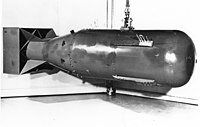
Photo from wikipedia
The interannual variability of the boreal winter (DJF) subtropical jet stream (STJ) is analyzed over the Coordinated Regional Downscaling Experiment—Central America, Mexico, and Caribbean domain (CORDEX-CAM) during 1980–2010. We use… Click to show full abstract
The interannual variability of the boreal winter (DJF) subtropical jet stream (STJ) is analyzed over the Coordinated Regional Downscaling Experiment—Central America, Mexico, and Caribbean domain (CORDEX-CAM) during 1980–2010. We use simulations with the regional climate model RegCM4 (version 7) at 25 km resolution driven by ERA-Interim (RegERA) and three global models (RegGCMs). The simulations are evaluated using zonal winds at 200 hPa level from ERA-Interim and MERRA2, which show similar results, and no significant trends in the STJ. Despite some biases, RegERA captures the STJ variability and its relationship with several teleconnections. The polarities of the principal mode of variability of the Pacific and Atlantic jets are significantly anti-correlated; they represent the longitudinal extension/retraction and the poleward/equatorward migration of the jet cores, respectively. During El Niño and the + PNA (Pacific North America), the North Pacific jet exit region and the North Atlantic jet show maximum speeds equatorward of their climatological positions. During these conditions, there is an extended and strong STJ over the domain; this pattern also tends to occur during the negative phases of the Arctic and North Atlantic oscillations. The RegGCMs simulate better the principal modes of the Atlantic jet variability than those of the Pacific jet exit region; nevertheless, they reproduce the observed sign of the variations of the jet speeds and their latitudinal changes in the two basins. They also partially capture the sign of the temperature and precipitation anomalies in the domain, which respond to the STJ polarities and their interaction with the teleconnections.
Journal Title: Climate Dynamics
Year Published: 2020
Link to full text (if available)
Share on Social Media: Sign Up to like & get
recommendations!